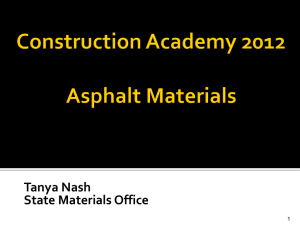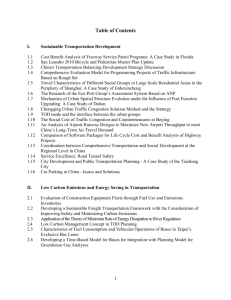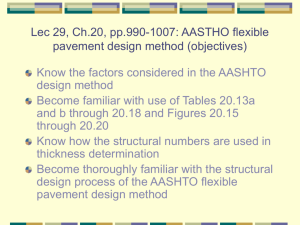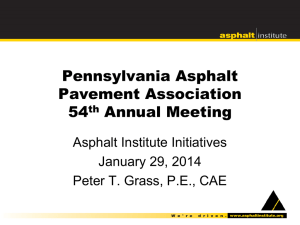Flexible Pavement Design-Asphalt Institute Method - Icivil-Hu
advertisement
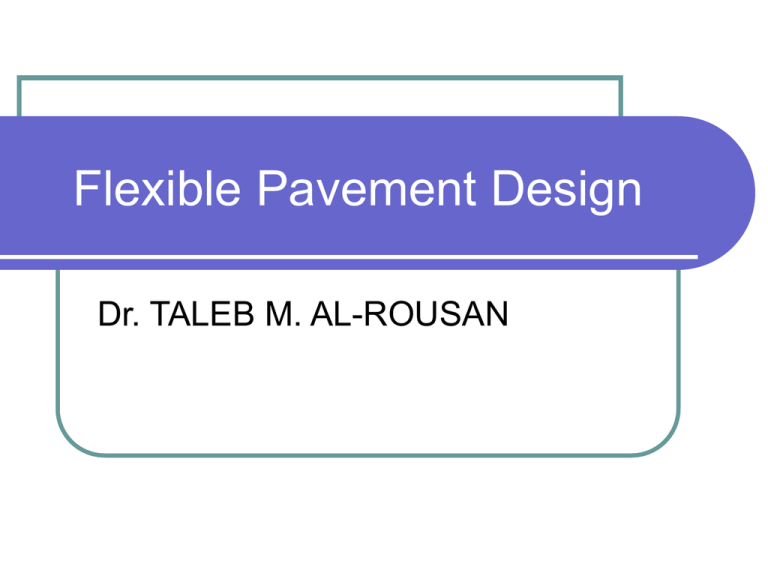
Flexible Pavement Design Dr. TALEB M. AL-ROUSAN Pavement Types 1. Flexible Pavement: Pavement constructed of bituminous & granular materials. A structure that maintains intimate contact with subgrade and distribute loads to it, and depends on aggregate interlock, particle friction, and cohesion for stability. Pavement Types Cont. 2. Rigid pavement: Pavement constructed of Portland cement concrete. It is assumed to posses considerable flexural strength that will permit it to act as a beam and allow it to bridge minor irregularities in base and subgrade. Cross Section Components Cross section consist of (from top): 1. 2. 3. 4. 5. 6. 7. 8. 9. Seal coat Surface course Tack coat Binder course Prime coat Base course Subbase course Compacted subgrade Natural subgrade The use of various courses is based on either necessity or economy, and some of the courses may be omitted. Typical Cross Section Seal Coat Seal coat: Thin asphalt surface treatment used to: 1. 2. 3. 4. Waterproof or seal the surface. Rejuvenate or revitalize old bituminous wearing surfaces. To nonskid slippery surfaces. Improve night visibility. Single Surface treatment = single application of bituminous material that is covered by a light spreading of fine aggregate or sand (spread mechanically) then compacted with pneumatic tired rollers. Surface Course Is the top course of asphalt pavement (Wearing course). Constructed of dense graded HMA. Must be: 1. 2. 3. Tuff to resist and withstand wear & abrasive effects of moving traffic & stable to prevent permanent deformation. Provide smooth and skid resistant riding surface. Water proof to protect the entire pavement from the weakening effects of water. If the above requirements can not be met, the use of seal coat is recommended. Binder Course Binder course (known also as Asphalt base course) is the asphalt layer beneath the surface course. Reasons for use: 1. 2. HMA is too thick to be compacted in one layer (if the binder course is more than 3” it is placed in two layers). More economical design, since binder course generally consist of larger aggregates and less asphalt and doesn’t require high quality. Tack & Prime Coats Tack coat: Very light application of asphalt (emulsion) to ensure a bond between the surface being paved and the overlying course. Binds asphalt layer to PCC base or to an old asphalt pavement. Prime coat: Application of low viscosity Cutback asphalt to an absorbent surface such as untreated granular base on which asphalt layer will be placed on. It binds the granular base to the asphalt layer. Tack coat doesn’t require the penetration of asphalt into the underlying layer, while prime coats penetrates into the underlying layer, plugs the voids , and form a watertight surface. Both are spray application. Base & Sub Base Courses Base course: Layer immediately beneath the surface or binder course. Composed of crushed stone, crushed slag, or other untreated or stabilized materials. Has good stability & density Distributes & spreads the stresses created by wheel loads so that the stresses transmitted to the subgrade will not be great to result in excessive deformation or displacement of that foundation. Subbase Course Subbase course: Layer beneath the base course, used mostly for economy purposes since it can be of lower quality. Subbases may be used in areas where: 1. 2. 3. frost action is sever, or Subgrade soil is extremely weak, or Where construction working table is needed. Subgrade Subgrade can be either in situ soil or a layer of selected materials. The top 6” of subgrade should be scarified and compacted to the desired density near the optimum moisture content. Full-Depth Asphalt Are constructed by placing one or more layers of HMA directly on the subgrade or improved subgrade. Used for heavy traffic. When local materials are not available to minimize the administration and equipment costs. Typical cross section: Asphalt surface, tack coat, asphalt base, and prepared subgrade. Full-Depth Asphalt Cross Section Advantages of Full-Depth Asphalt 1. 2. 3. 4. 5. 6. Have no permeable granular layers to entrap water and impair performance. Reduced construction time. Construction seasons may be extended. Provide & retain uniformity in the pavement structures. Less affected by moisture or frost. Little or no reduction in subgrade strength because moisture do not build up in subgrade when full-depth asphalt is used. Elements of Thickness Design 1. 2. 3. 4. Traffic Loading Climate or Environment Material Characteristics Others: Cost, Construction, Maintenance, Design period. Traffic Loading Pavement must withstand the large umber of repeated loads of variable magnitudes Primary loading factors: 1. 2. 3. Magnitude of axle loads (controlled by legal load limits). Volume & composition of axle load (Traffic survey, load meters, & growth rate). Tire pressure & contact area. Equivalent Standard Axle Load ESAL (80 kN (18,000 lb or 18 kips) single axle load. The total no. of ESAL is used as a traffic loading input in the design of pavement structure. Climate or Environment 1. 2. Climate or environment affect the behavior & performance of materials used in pavements Temperature: high temp. cause asphalt to loose stability, low temp. cause asphalt to become hard & stiff, and frost heave. Moisture: Frost related damage, volume changes due to saturation, chemical stability problems with moisture existence (Stripping). Material Characteristics 1. 2. 3. Required materials characteristics: Asphalt surface: Material should be strong & stable to resist repeated loading (fatigue). Granular base & subbase: gradation, stable & strong to resist shears from repeated loading. Subgrade: soil classification, strong & stable. Various standard tests are available for determination of desired properties. CBR, Marshal stability, Resilient Modulus, Shear strength. Mr (psi) = 1500 CBR or Mr (Mpa) = 10.3 CBR Asphalt Institute Method Method is based on two assumed stress –strain conditions: 1. Wheel load (W) is transmitted to the pavement surface through the tire at a uniform vertical pressure (Po). The stresses are then spread through the pavement structure to produce a reduced max. vertical stress (P1) at the subgrade surface. 2. The wheel load (W) causes the pavement structure to deflect creating both compressive & tensile stresses in the pavement structure. Asphalt Institute Method Cont. 1. 2. This method considers the following strains as being responsible for the most common traffic related distresses: Horizontal tensile strains (Et) on the bottom of the asphalt layer (causes fatigue cracking). Vertical compressive strains (Ec) on the top of subgrade (causes permanent deformation). Et & Ec are used as failure criteria Asphalt Institute Method Cont. Asphalt Institute thickness design manual was prepared using a computer program and suitable data. The manual includes charts for six types of pavement structures, and three sets of environmental conditions based on the mean annual air temp. (45o, 60o, and 75o F). Example design chart is shown in the coming slide. Materials Evaluation The design subgrade (Mr) should be based on expected level of traffic expressed in ESALs. To ensure more conservative design, lower value of (Mr) is used for higher volumes of traffic. It is recommended that (Mr) is found for (6 to 8) samples of subgrade. Arrange Mr values in descending order. Plot as cumulative distribution. Chose design subgrade (Mr) from the curve as follows: Design Subgrade Mr Mr test Value 13500 % values Value >= >= 1 Subgrade Design Limits 12.5 11900 2 25 11300 3 37.5 10000 4 50 9500 5 62.5 8800 6 75 7800 7 87.5 6200 8 100 Traffic Level Design Percentile ESAL Value <= 10,000 60 10000 to 1000,000 75 > 1000,000 87.5 Design Mr 120 100 % >= 80 60 40 20 0 0 2000 4000 6000 8000 Mr (psi) 10000 12000 14000 16000 Resilient Modulus (Mr) AASHTO T292 (Resilient Modulus of Subgrade soils). (Mr) can be found using repeated loading procedure test such as (unconfined compression test or triaxial compression test). 0.1 sec loading and 1 to 3 sec. unloading. Linear Variable Displacement Transducers (LVDTs) are used to measure strains. Elastic modulus based on the recoverable strain under repeated loading is called the resilient modulus (Mr) = (Deviator stress/ Recoverable axial strain) Deviator stress = Axial stress – confining pressure Recoverable axial strain = Max strain – permanent strain See Fig. 16.2 Subgrade Mr Seasonal Variation Freeze Time Recovery Time Traffic Analysis Estimate the number of vehicles of different types (Passenger cars, single unit trucks, multi unit trucks of various sizes) expected to use the pavement over the design period. Design should make allowance for traffic growth using historical records or comparable facilities. 1. Expected Traffic Volume During Design Period T = [( (1 + G)Y -1)/ G ] T1 T: Expected traffic volume during design period. T1: Traffic volume during first Year. G: Rate of growth. Y: Design period (yrs). [( (1 + G)Y -1)/ G ]: compound rate of growth. Traffic Analysis Cont. 2. Estimate the (%) of total truck traffic expected to use the design lane. Design lane: Lane expected to receive the severe service. % of trucks is found by observation or using some prepared tables. (see Table 16.1). Axle & Wheel Configurations Single Axle with Single Tire Tandem Axles with Dual Tires Single Axle with Dual Tires Tridem Axles with Dual Tires Traffic Analysis Cont. 3. For each weight class, determine the truck factor. Truck Factor: The no. of ESALs contributed by passage of a vehicle. TF = [SUM (No. of axles in each wt. class X EALF)] / Total No. of vehicles Truck factor can be estimated Using Table 16.2 Equivalent Axle Load factor or Load equivalency factor (EALF) presented in Table 16.3. EALF: Defines the damage per pass to a pavement by the axle of question relative to the damage per pass of a standard axle load (80 kN or 18-kip) EALF depends on type of pavement, thickness or structural capacity, and failure conditions (based on experience). See Figure 16.8. Truck Factor Example Traffic Analysis Cont. 4. Multiply Tf by the no. of vehicles in each group and get the sum for all groups. ESAL = Sum (TF X No. of vehicles) all groups. See Examples 16.1 & 16.2 Example on Computation of ESAL Computing Design ESAL (Projected) Traffic Analysis Goal: To predict the number of repetitions of each axle load group during design period. The initial daily traffic is in two directions over all traffic lanes. Must be multiplied by direction distribution & Lane distribution to obtain initial traffic on design lane. Traffic to be used in design is the average traffic during design period (i.e. multiply by growth factor). Traffic Analysis ESAL = (ADT) (T) (Tf) (G) (Y) (L) (D) (365) ADT: Average daily traffic at the start of the design period. (T): % of trucks in the ADT. (Tf): Truck factor G: Growth factor Y: Design period L: Lane Dist. Factor D: Directional dist. Factor Note (G Y) = Combined growth rate… use formula to calculate. ESAL Example A two-lane major rural highways has an AADT of 4000 during the first year of traffic, 25% trucks, 4% annual growth rate, and 50% on the design lane. Compute the ESAL for a design period of 20 yrs. Use truck factor of 0.38. Consider lane Dist. = 1.0. Solution ESAL = (ADT) (T) (Tf) (G) (Y) (D) (L) 365 (G) (Y) = [(1 + G)y - 1]/ G = [(1 + 0.04)20 - 1]/ 0.04 = 29.78 ESAL = (4000) (0.25) (0.38) (29.78) (0.50) (1.0) 365 = 2, 065, 200 Planned Stage Construction Involves successive application of HMA layers according to a predetermined time schedule. Beneficial when: Funds are insufficient for constructing a pavement with long design life. Great amount of uncertainty in estimating traffic. • Concept: Remaining life which implies that the second stage will be constructed before the first stage shows serious signs of distress. Planned Stage Construction Cont. Pavement is designed for initial traffic & next stage can be designed using traffic projections based on traffic in service. Stage construction allows weak spots that develop in the first stage to be detected and repaired in the second stage. Planned Stage Construction Cont. n1: Actual ESAL for stage 1 N1: Allowable ESAL for initial thickness (h1) selected for stage 1. Then The damage ratio (Dr) at the end of stage 1 is: Dr = n1/ N1 Dr < 1.0 ………. When Dr =1.0 pavement fails. (1-Dr) = Remaining life in the existing pavement at the end of stage 1. h1 is obtained based on Dr =1.0. To keep some life, h1 should be determined based on adjusted ESAL (N1) > ESAL (n1) N1= n1/Dr Planned Stage Construction Cont. n2: Design ESAL for stage 2. N2: Allowable or adjusted ESAL to permit selection of (h2) that will carry traffic n2 and use the remaining life in stage 2. Then The damage incurred in stage 2 should not exceed the remaining life. n2/ N2 = (1-Dr) N2 = n2/ (1-Dr) h2 –h1 = Additional thickness required in stage 2. MS-1 recommended (5 – 10 yrs) stage 1 with 60% Dr. Planned Stage Construction Example Given: Full-depth asphalt pavement subgrade Mr = 10,000 psi Use two stage to construct this pavement Stage 1: 5 yrs, ESAL = 150,000 , Dr = 60% at the end of stage 1. Stage 2: 15 yrs, ESAL = 850,000 Required: Determine thickness of HMA required for first 5yrs. Thickness of overlay required to accommodate the additional traffic expected during the next 15 yrs. Planned Stage Construction Example Cont. Solution: n1=150,000 & Dr = 0.6 Find N1 = n1/Dr = 150,000/ 0.6 = 250,000 From design Chart with N1 & Mr find h1=7.3 in use 7.5 in. n2 = 850,000 & 1-Dr = 0.40 Find N2 = n2/ (1-Dr) = 850,000/ 0.4 = 2,100,000 From design chart with N2 & Mr find h2 =11.0 First stage thickness = h1 = 7.5 in Overlay thickness = h2 –h1 = 11.0 – 7.5 = 3.5 in. Planned Stage Construction Example Cont. Solution: If the design was not divided into 2 stages, the thickness of the pavement using (Mr = 10,000 psi & ESAL = 1000,000) is : 9.8 in use 10 in. The use of stage construction decreased the thickness in first stage by (10.0 -2.5 = 2.5 in), but increased the total thickness by (11.0 - 10.0 = 1.0 in).


